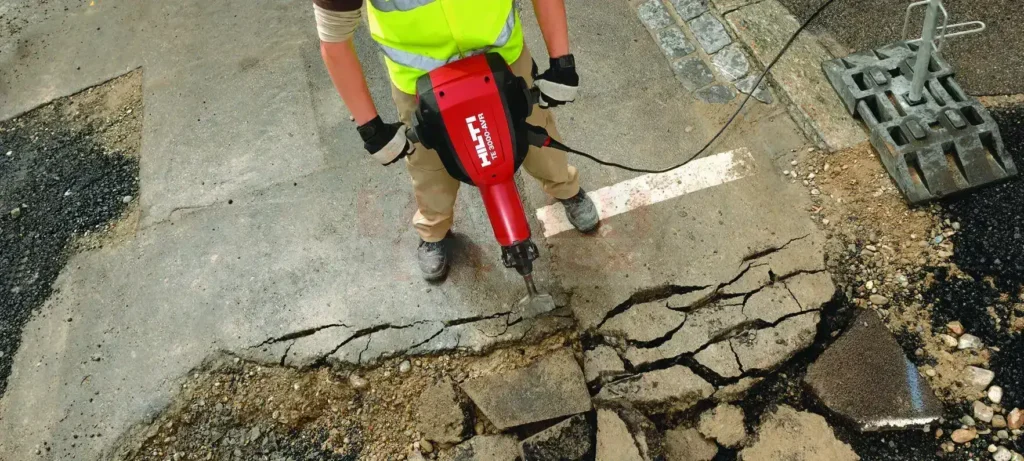Rebar is used to improve the strength of concrete. Concrete remains strong under compression but can easily crack when subjected to tensile or bending forces. Rebar provides it with tensile strength, thus improving its overall durability.
The use of rebar in concrete enables it to bear heavier loads and increase its serviceable life. It helps maintain the strong structure of the buildings, bridges, and roads that are constructed over the surface of the earth and then protected from any more factors that could contribute to their damage over time. This is the article that gives all about rebar in concrete, its importance, and how it serves construction projects.
What Is Concrete Rebar?

Concrete rebar is the steel reinforcement that is placed in concrete structures. It is embedded in wet concrete to impart strength and stability to build stronger and more durable buildings, roads, and bridges.
The rebar has a texture with ridges or bumps, and as the concrete hardens, it grips the reinforcement bar and holds it firmly. These prevent cracks from happening, and the structure remains intact. Nowadays, concrete rebar is vital for modern construction.
Does All Concrete Need Rebar?
To provide the concrete structure with strength, durability, and long life, it is used in rebar reinforcement. It significantly increases the shelf life of concrete, reducing the tendency for cracking and helping it resist overload and stresses due to environmental conditions over some time.
- Concrete Slabs & Footings: Gives support from cracks and settling.
- Concrete Walls: Vertical and lateral load-strength wall framing.
- Columns and Beams: Give stability by resisting compression and tension.
- Bridges, Overpasses, and Other Heavy Infrastructure: Resists dynamic forces, heavy loads, and environmental stress for long-lasting performance.
In some cases, it becomes redundant and unnecessary to provide reinforcement. A concrete pad of small size with very low loads is considered an example of the application of reinforcement like walkways or patios. In such cases, however, either rebar or some other form of reinforcement like welded wire mesh should be used in the concrete to avoid cracking because of temperature or moisture changes.
Why should you use rebar?
Rebar, or reinforcement bars, is perhaps the most essential aspect of the entire components of concrete construction.
You must be probably using it for each construction you do for the following reasons:
Increased Strength: Although concrete is strong when compressed, it does not possess strength on tension. Rebar allows the concrete to counteract this shortcoming. When the tensile forces come into action on concrete (such as during bending or stretching), the rebar holds some portions of that tensile stress and avoids cracks or failure in the concrete.
Prevention of Cracking: The cracks that develop in concrete often arise from various conditions like temperature fluctuations, shrinkage, or external loads. Cracking of concrete without reinforcement could easily compromise the integrity of the whole structure, eventually leading to deterioration. Thus, rebar is needed to distribute loading and resist the formation and propagation of cracks.
Structural Integrity: To maintain the structural integrity of civil engineering structures such as bridges, dams, and buildings constructed at the height, they must be deemed important for preventing a fatal failure. The covered strength of concrete with the help of rebar is sure to bear the loads and other environmental forces applied to the structure.
Flexural Strength: This is the case where the importance of rebar comes into play since maximum strain is induced in applications such as beams, columns, and slabs. Thus, the presence of rebar in these structural elements ensures that they would be able to support the intended loads without excessive deflection or failure.
Durability: In fact, the durability of the concrete structures is improved when rebar is used since it minimizes corrosion, erosion, and fatigue’s effect on concrete structures. Strengthening the concrete constructions increases the service life of the structures as it supports enhanced resistance to environmental stresses.
Code Compliance: Several building codes and regulations mandate the use of rebar in specific types of concrete construction, particularly within seismic zones or other natural hazard areas. Compliance with these standards guarantees the safety and reliability of the structure.
Cost-Effectiveness: Although rebar increases the initial cost, it can save money in the long term by reducing maintenance and repair needs. Reinforced structures are less likely to suffer from early failure, preventing expensive repairs.
Cost-Effective: Though the addition of rebar initially raised the cost of concrete construction, however, it facilitates savings in the future by lowering maintenance and repair costs. Structures reinforced with rebar are less prone to expensive repairs or replacements due to premature failures.
Versatility: Rebar is available in different shapes, sizes, and grades that allow engineers to customize reinforcements to the specific requirements for a project. This allows an incredible variety of design parameters in the construction of a very wide array of concrete structures.
Types of Rebar
1. Carbon Steel Rebar (Mild Steel)
Mild steel is made of carbon steel and is most popular for use in concrete constructions. It is both strong and cost-effective. However, it is subject to corrosion, especially in moist and chemically aggressive environments, which also ends up affecting its life.
2. Epoxy-Coated Rebar
Such an epoxy-coated rebar has the precaution of covering up with epoxy resin well, as the name suggests. The epoxy coating permits water vapor or moisture to blow through itself but significantly prevents corrosion in hostile environments for exposure to salty water and chemicals making the bar excellent options for coastal and bridge constructions. However, this epoxy coating can be damaged and, therefore, would report failures in the protective qualities.
3. Galvanized Rebar
Galvanization offers zinc-coated rebar corrosion resistance. It is proved tough concerning damage, compared to even epoxy-coated rebar, and is well operational in circumstances of humidness or chemicals. The point where the costliest portion stands is compared to the other standard types.
4. Stainless Steel Rebar
Stainless steel rebar proves highly resistant to rust and has a sturdy capability of strength and durability. The costliest option out of all, it is mostly used in places where extreme conditions are found, such as in offshore cases or in corrosive industries. This quality, along with the succeeding period, has designated it as a top choice project in the specialty area.
5. Welded Wire Fabric (WWF)
Welded wire fabric consists of welded steel wires laid down in a grid pattern. It is highly suitable for applications where large flat surfaces need reinforcement, such as in floors and pavements. It can also be applicable in slab-on-ground structures and small concrete canals specific to attributes similar to that of rebar.
6. Glass Fiber-Reinforced Polymer (GFRP) Rebar
Rebars known as GFRP are indeed laminated with glass fibers and polymer resin; such a method of construction is surely a non-corrosive alternative to steel rebars. Most benefits will be derived in places with huge problems given rust and corrosion, especially in marine constructions. It will cost a lot compared to traditional steel rebars.
7. European Rebar
European rebar is produced with manganese, which reduces the cost of production, resulting in a flexible bendable substance. It is less expensive but is not normally fit for high seismic areas, as well as those jobs where high structural integrity is required. Its flexibility makes it a very convenient and easy product to work with but reduces its strength when compared to other forms.
8: Reinforcing Bars made of Sheet Metal
Reinforcing bars made of sheet metal are fabricated from an annealed sheet of steel, bent into corrugations with holes punched at regular intervals. These bars are often lighter and needed for reinforcement such as that found in floor slabs, stairs, and roofs. The bars are sufficiently strong for small construction applications that are less demanding.
9. High-Strength Rebar
High-strength rebar has been specifically designed to be able to give a useful domain of tensile strength in comparison with standard rebar. For this reason, it is accomplished with high-strength levels for large construction works like bridges and skyscrapers, where high strength is imposed for the support of massive loads. Most of the time, this type of rebar is made of alloy steel.
Benefits of Rebar in Concrete
Benefit of adding steel rebar to concrete is that it supports the tensile strength of the concrete. By itself, concrete is brittle and tends to crack when any tension is placed upon it. The reinforcement allows the concrete to withstand these forces, resulting in stiffer and stronger structures.
Similarly, the rebar execution in the buildings increases their capacity to absorb energy originating from an earthquake; thus minimizing chances of collapse and extensive damage during an event. Therefore, this type of construction is very well suited for safety in earthquake design areas.
Reinforcement comes with different grades and types of rebar and this flexibility allows engineers to design reinforcements to specified needs in different projects. Therefore, concrete could be designed to be strong, durable, and might perform excellently under varying conditions.
Choosing the Right Size of Rebar
The size of rebar determines the strength and security of a concrete structure; it depends on load requirements, the size of the structure, and the type of concrete in use. For instance, for smaller projects, the size of rebar, such as sidewalks or driveways, may be used compared to larger structures, bridges, or high-rise buildings, which require large-size rebar for additional reinforcement.
The most conventional sizes of rebar are presented with a number based on the diameter, such as #3, #4, #5, etc. A #3 is 3/8″, and a #5 has a diameter of 5/8″. The size of the number represents its thickness and strength. As such, the choice size for each project must go by the engineering recommendations along with building codes.
In some instances, the size of the rebar might also be based on environmental conditions. High humidity and salt water may cause a greater risk of corrosion in some areas. In these cases, bigger or more corrosion-resistant rebar would be advised. Selecting the proper size of the rebar is necessary for ensuring the durability of concrete and safety over time in the structure.
Conclusion
To make concrete have tensile strength, rebar is introduced. Concrete is strong in compression yet weak in tension, which makes it easily cracked off from the tensile side. Rebar helps concrete withstand tensile forces that try to cause bending and stretching.
Rebar increases durability. It prevents crack growth and reduces damage to the structure, enabling it to last longer. Thus, rebar is an essential part of strong, safe, and long-lasting concrete construction.
FAQS
Q1) How does rebar increase the durability of concrete?
Rebar makes concrete long-lasting by resisting cracks. It also protects the structure from environmental damage.
Q2) Is it possible for concrete to survive without rebar?
Concrete can survive without rebar, but it will be weak and prone to cracking. Rebar makes it much stronger.
Q3) What happens if rebar is too small for concrete?
If the rebar is too small, then it cannot offer enough strength. The time can easily cause cracks and structural failure.


